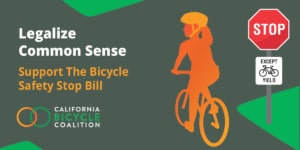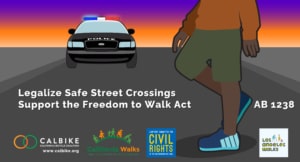On October 8, 2021, the governor vetoed two bills that CalBike had sponsored: The Bicycle Safety Stop Bill (AB 122, Boerner Horvath) and the Freedom to Walk Act (AB 1238, Ting). In both cases, he cited data collected by police and, therefore, marred by police biases. In 2021, it should be unacceptable to rely on police accounts when making decisions about public safety. On top of that, Newsom presented slices of data cherry-picked to support his vetoes.
Here’s why Governor Newsom’s statistics, and the conclusions he reached, were misleading, disingenuous, and just plain wrong.
The governor’s defective data on biking
The governor’s veto of the Bicycle Safety Stop demonstrates how inaccurate reporting of bike crashes harms bike safety efforts. The governor cited statistics from the Statewide Integrated Traffic Reporting System (SWITRS), California’s database of crash reports compiled by police departments around the state. It is the only official source of data about the cause of traffic crashes.
In his veto message, Newsom’s claim that 88% of the people killed while biking past a stop sign were at fault displays a fundamental failure to understand safe bicycling or account for the anti-bike bias that is endemic to policing. And, unfortunately, police have only the car driver’s word for what happened after they have killed someone on a bike.
For example, when Amelie le Moullac was killed in San Francisco by a truck turning right into her path, the police report faulted the bicyclist for running into the side of the truck. SFPD didn’t even bother to look for evidence to back up this anti-bike assumption. It was the San Francisco Bicycle Coalition that found camera footage of the crash, proving that Ms. le Moullac was standing legally in the bike lane when the truck turned into her.
According to SWITRS, people on bikes and walking are constantly throwing themselves in front of law-abiding drivers and suffering death and injury as a result.
SWITRS data is unreliable. Police aren’t trained in the choices people on bikes make to ensure their safety, and they then make assumptions about who is at fault in a crash based on preconceived ideas about bicyclists’ bad behavior. Unfortunately, this unverified information influences policy debates throughout California. When the media reports on a controversial bike safety improvement, reporters cite SWITRS that claims half of all bike crashes are the bicyclist’s fault. That false statistic reduces the political will to take the actions needed to truly make the streets safe for people on bikes.
Cherry-picked pedestrian data leads Newsom to the wrong conclusion
In his veto statement for the Freedom to Walk Act, the governor used CHP talking points to blur the truth about what really makes pedestrians most vulnerable: prioritizing fast-moving cars and trucks over human life. People walking don’t stand a chance when two tons of steel take ownership of public streets, and crashes are considered the collateral damage of modern life.
The biggest problem with Newsom’s cherry-picked SWITRS data is that he didn’t include ALL pedestrian crashes. He just cited fatalities, but fatal crashes represent only a small share of the accidents where cars hit pedestrians, and using this figure gives a distorted picture of street safety.
When you look at all crashes involving a car and a pedestrian, it becomes clear that it’s not those crossing outside of crosswalks that are at most danger. California’s own data show that 44% of all pedestrian crashes occur when someone is “crossing at a crosswalk in an intersection.” Almost 70% of collisions involving pedestrians are caused by the driver disregarding a traffic law.
In addition, SWITRS data is drawn from accident reports prepared by the police, who have a notoriously anti-pedestrian bias. It’s not surprising that police would find pedestrians at fault for “taking actions against traffic controls or safety laws” in 63% of fatal crashes. Police, and our society at large, don’t place enough responsibility on car drivers to share the road responsibly with other road users.
When did the penalty for walking outside of proscribed pedestrian boundaries become a death sentence?
It is inaccurate for the governor, using arguments from the CHP, to insinuate that illegal crossings are the reason for rising pedestrian fatality rates. There’s no evidence of a rise in jaywalking correlated with an increase in pedestrian fatalities. In fact, recent data from the state of Virginia shows the opposite. After the state decriminalized jaywalking earlier this year, initial data indicates that it hasn’t made pedestrians less safe.
But there is a correlation that increased distracted driving and a trend toward higher front grills, mainly on trucks and SUVs, which reduce visibility for drivers and increase the deadliness of car-pedestrian crashes that correlates with this increase.
Also, it is not surprising that the most deadly crashes happen outside of crosswalks, where drivers travel at much higher speeds.
How to get accurate accident data
The prevalence of faulty data in these reports is also an argument for reducing the police role in traffic crash reporting. The movement to refocus police energy away from such activities is growing. For instance, the City of Berkeley is considering transferring that duty to its Transportation Department to allow police officers to focus more on crimes they are better equipped to deal with, an initiative that CalBike supports.
Fact-checking SWITRS accident reports would go a long way toward changing the narrative about who causes the most harm on our street. But it will be a big job to comb through the data, investigate the facts, and prepare more truthful reports. Still, it’s a critical job. If you know someone willing to analyze the SWITRS data and provide more accurate accident data, contact Jared Sanchez at jared@calbike.org.




